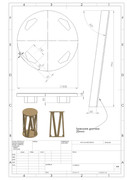- This topic has 4 replies, 3 voices, and was last updated 6 years, 9 months ago by
 Stefanosky.
Stefanosky.
-
AuthorPosts
-
22 July 2017 at 18:33 #10155
Prendendo come esempio l’immagine del tavolo da lavoro utilizzato da alcuni grattavetro statunitensi, ho pensato di farmene una copia in 3D con Solidoworks per vedere che tutto tornasse e per avere nero su bianco le misure dei tagli, degli angoli, degli ingombri ecc.
Visto che è venuto a mio avviso un ottimo lavoro e che il progetto rende molto stabile il tavolo in questione, lo condivido volentieri con voi… Magari a qualcuno potrebbe tornare utile.
Al momento mi manca da dare un paio di mani di impregnante e farci il sistema di supporto regolabile del blank che farò in settimana. Ovvio che il tavolo andrà zavorrato al suo interno per ottenere la stabilità voluta.
Io l’ho fatto di diametro 50cm e altezza 85cm perchè sono le misure che ho ritenuto più giuste ma nulla vieta di adattarlo come meglio si crede. Non potevo certo mettermi in casa un bidone di olio, sennò la moglie chi l’avrebbe sentita!Note per il montaggio:
Usare sia viti che colla per fissare le varie parti.23 July 2017 at 0:42 #10158I always have doubts about the base
 23 July 2017 at 9:08 #10159
23 July 2017 at 9:08 #10159What do you mean?
23 July 2017 at 22:06 #10160I see that the 8 stays will make the entire structure of the cylinder that makes up the table very rigid.
I make an argument a “freewheel”, and as regards the round base, I would look for a way to delegate not all of its base surface to contact with the ground, but let it touch the ground with three points on its circumference, or simulate the use of the classic ex oil drum which (although in theory), touch the floor with (some random points) of its raised edge which, however, are found only on its circumference, while a completely flat surface could touch the ground with points even very close to each other, and therefore make everything more swaying.
All this in theory to be experimented. But then, to correct any flaws in contact with the floor usually compensates for a good ballast equal to the weight of the person “will scratch”.
Clearly such a ballast has a volume that can be important (I used my brick weight) and it depends on the objects you can use to form that ballast, who will have to stay still and contained on the base of the table.
23 July 2017 at 22:55 #10162Actually the base with the ballast inside, eg bricks, it adapts to the floor and has no movement whatsoever… With felt pads scattered here in the tiles of the house it is perfect. However I could also put on some feet but at the moment I don't feel the need.
-
AuthorPosts
- You must be logged in to reply to this topic.

